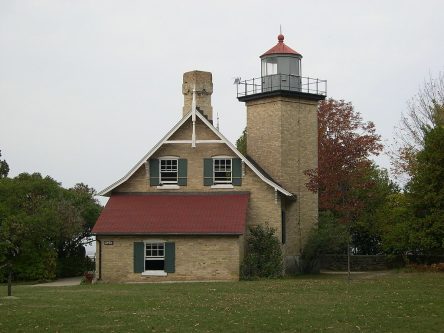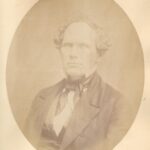Orlando Metcalfe Poe (1832-1895) was an engineer who shaped the landscape of Wisconsin’s harbors and waterways, playing a crucial role in the development of Wisconsin’s commerce. Through his lighthouse designs and his design of major systems of ship locks and canals on the Great Lakes, Poe connected Wisconsin, its people, and its products to the growing world of water shipping in 19th century America.
Poe graduated from West Point Military Academy as an engineer in 1856. With the outbreak of the Civil War in 1861 he used his skills in various theaters to reach the rank of Brigadier General. After the war, Poe was appointed by U.S. President Andrew Johnson to the position of Engineer Secretary of the U.S. Lighthouse Board, a federal agency responsible for the construction and maintenance of all navigational aids in America. His appointment made him responsible for all the lighthouses on the Great Lakes.
One of Poe’s lasting legacies is his lighthouse design which became known as the “Poe Style.” Defined by tall, brick structures gently tapering from bottom to top, Poe Style lights allowed for taller lighthouses than previously built, enabling ships to see the light from a farther distance. Poe’s design used a conical shaped exterior which stabilized the structure with minimal use of ready materials. The designs were both architecturally beautiful and practical. The arched windows let out more light, and the gallery supports, the angled pieces just below the platform, allowed a larger light platform to rest on a narrower tower top. In all, Poe designed ten lighthouses including ones at Presque Isle, Grosse Point, Au Sable, Outer Island, Wind Point, Little Sable, and Seul Choix, as well as the Spectacle Reef Light in Lake Huron. All of these still remain standing as a monument to his specific design.

Poe’s lighthouse style revolutionized how mariners safely traveled Wisconsin’s waterways. Lighthouse designs before Poe entered the scene were of limited height such as the Eagle Bluff lighthouse in Peninsula State Park in Door Country, pictured below. To gain height they had to be built on a bluff or hill. The height of a lighthouse was crucial for safety because the higher the light was above the water the farther out into the water boats and ships could see it. The distance the light projected, along with each light’s unique rotating pattern, allowed mariners to calculate their position.



The expansion of Great Lakes traffic and the need for navigation aides greatly increased after the 1857 passage of the steamship City of Superior, carrying copper, from Superior, WI, to Cleveland, OH. Iron ore was the first resource shipped east from Marquette County, MI, in 1850. Other cargo included fish, grain, lumber and passengers shipped from several ports along the southern coast of the Lake Superior. In 1857 a lighthouse was built on the Apostle Island called Michigan Island to guide ships to the port at La Pointe on Madeline Island, which was a principal port on the western end of Lake Superior. In the following years, La Pointe was surpassed by ports in Duluth, MN, and Superior, WI. In 1874, Poe designed the Outer Island Lighthouse, which sits at the outer edge of the Apostle Islands to better navigate ships to the far end of Lake Superior. Railroads connecting iron mines in the Minnesota Mesabe Range and the Duluth and Superior ports led to a rise in iron ore shipments.
Lighthouses were not the only important mechanism for water traffic. The construction of locks to bypass the 21-foot drop of the St. Mary’s River at the eastern end of Lake Superior also helped move goods and people quickly through the Great Lakes. A small lock built in 1797 on the Canadian side of St. Mary’s River, which connects Lake Superior and Lake Huron at Sault Saint Marie, allowed ships to travel from the lower Great Lakes to Lake Superior without a portage or carrying the boat and its cargo. When forced to portage, the ships had to unload their cargo and then pull onto land around the St. Mary’s River Falls. This small lock on the Canadian side was followed by several locks on the American side. The increase in iron ore and grain industries and the construction of bigger ships to transport these shipments lead to the need for larger and larger locks.


In 1883, Poe was appointed by the U.S. Government as Superintendent Engineer to improve the rivers and harbors on Lakes Superior and Huron. In this capacity, he helped design the St. Mary’s Falls Canal and what is now called the first Poe Lock. His design allowed much larger ships to transit the falls, relieving the previous backup. Poe’s locks allowed for the construction of larger ships, which, in turn, grew the shipping industry of Duluth and Superior. By this time the American locks are being called the Soo Locks.
Orlando Poe was an important figure who influenced shipping traffic on the Great Lakes and commerce in Wisconsin. His lighthouse design helped guide shipping safely around lake hazards by allowing the lights to be higher. His lock design allowed larger ships to pass easily from the lower Great Lakes to Lake Superior, lowering the cost of shipping and increasing the volume. Even as lighthouses go out of service, his projects still attract visitors to Wisconsin today.
Written by Cheryl Kaufenberg, May 2023.
SOURCES
Kraig Anderson, “Wind Point Lighthouse,” Light House Friends (website). https://www.lighthousefriends.com/light.asp?ID=242
Frank Jacobs, “Maps of Great Lakes shipwrecks detail one of North America’s biggest graveyards,” Big Think, 7 April 2022. https://bigthink.com/strange-maps/great-lakes-shipwrecks/
United States Army Corps of Engineers, “Soo Locks Visitor Center.” https://www.lrd.usace.army.mil/Missions/Recreation/Display/Article/3833525/soo-locks-visitor-center/
United States National Park Service, “Historic Lighthouses and Light Stations in Wisconsin,” National Park Service Martime Heritage Program. https://www.nps.gov/maritime/inventories/lights/wi.htm



